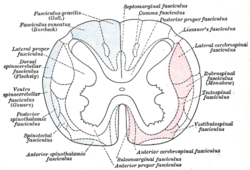Posterolateral tract
| Posterolateral tract | |
|---|---|
 Diagram showing a few of the connections of afferent (sensory) fibers of the posterior root with the efferent fibers from the ventral column and with the various long ascending fasciculi. (Lissauer's fasciculus visible in upper left.) | |
 Diagram of the principal fasciculi of the spinal cord. (Lissauer's fasciculus visible in upper right.) | |
| Details | |
| Identifiers | |
| Latin | tractus posterolateralis |
| NeuroNames | 782 |
| NeuroLex ID | nlx_143969 |
| TA98 | A14.1.02.228 |
| TA2 | 6092 |
| FMA | 72616 |
| Anatomical terms of neuroanatomy | |
The posterolateral tract (fasciculus of Lissauer, Lissauer's tract, tract of Lissauer, dorsolateral fasciculus, dorsolateral tract, zone of Lissauer) is a small strand situated in relation to the tip of the
Structure
This article needs additional citations for verification. (January 2013) |
The posterolateral tract contains centrally projecting
The posterolateral tract consists of fine fibers which do not receive their myelin sheaths until toward the close of
These fibers are intimately related to the
The non-myelinated fibers ascend or descend for short distances not exceeding one or two segments, but most of them enter the substantia gelatinosa at or near the level of their origin.
Clinical significance
During a complete occlusion of the
Eponym
The tract of Lissauer was named after German
References
![]() This article incorporates text in the public domain from page 762 of the 20th edition of Gray's Anatomy (1918)
This article incorporates text in the public domain from page 762 of the 20th edition of Gray's Anatomy (1918)
- S2CID 25597735.
